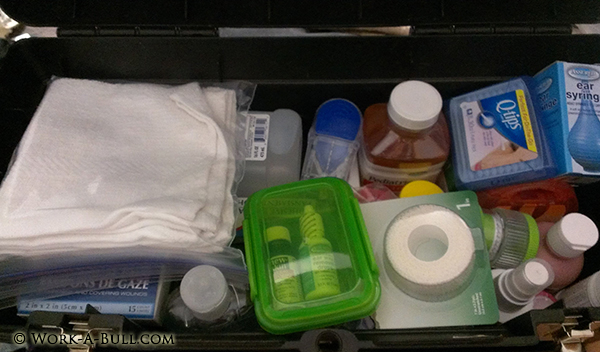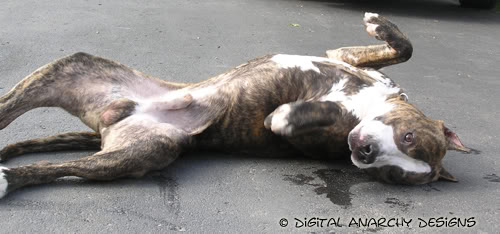 What turned out as a routine senior exam because Gus wasn’t feeling good has turned our life upside down for the last couple of weeks. Gus has lymphosarcoma. It isn’t slow moving and it is attacking his GI tract pretty nastily. Our vet didn’t have a whole lot of positive to say because of his age and susceptibility to succumbing if we opted to treat our beloved Elderbull with chemo. He said that the kindest option would be management and then helping him cross the bridge when the time came – which could be sooner or later.
What turned out as a routine senior exam because Gus wasn’t feeling good has turned our life upside down for the last couple of weeks. Gus has lymphosarcoma. It isn’t slow moving and it is attacking his GI tract pretty nastily. Our vet didn’t have a whole lot of positive to say because of his age and susceptibility to succumbing if we opted to treat our beloved Elderbull with chemo. He said that the kindest option would be management and then helping him cross the bridge when the time came – which could be sooner or later.
How did we find out and confirm our worst fears? Blood work. We had taken him in because his belly was a bit bloated and he didn’t want to eat his meals and was having trouble controlling his bladder. The latter is a common problem in the older dogs but I didn’t want him ending up with issues because he had an accident while we were at work and soiled his blanket in his crate.
The results from his blood work weren’t promising. He has hyper calcemia. He is anemic. His thyroid levels were incredibly low. All of that combined with the added insult, he also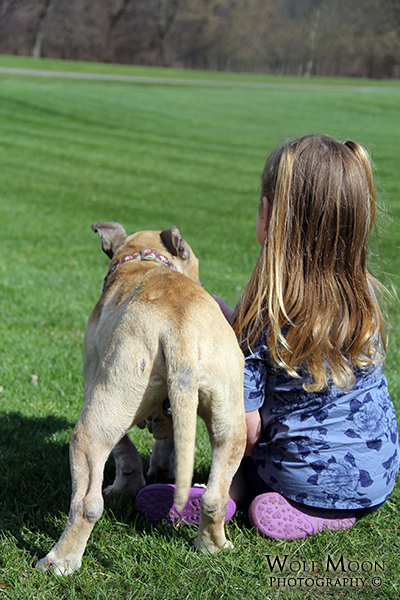 had a Urinary Tract Infection – the one thing we worked to prevent with his accidents. The final blow was the lymphosarcoma attacking his GI tract and causing the bloating and unwillingness to eat.
had a Urinary Tract Infection – the one thing we worked to prevent with his accidents. The final blow was the lymphosarcoma attacking his GI tract and causing the bloating and unwillingness to eat.
Cancer. It should be a curse word. This vile, vile disease is something that takes far too many loved ones from this Earth and runs rampant through our hearts as they deal and cope with this internal Hell until it is time for them to leave us. We’ve been dealing with it. We’re making our buddy comfortable. We are letting him eat whatever makes him eat and keep strength up. He has been getting to sleep in bed or we’ve been sleeping in the dog beds with him. We have to keep him cool since he gets uncomfortably hot even though he loves to bake in the sun. Whatever it takes for however long he has left with us.
We started a bucket list of things to do with him before he crosses the bridge – a “like” campaign on his Facebook page, Gus the Elderbull, in an effort to create a functioning memory that helps other dogs in shelters and a place for owners of their own elderbulls to come and share their memories, going swimming for the first time with us, eating an Oreo  cookie even though they aren’t good for him, spending all night cuddling with us.
cookie even though they aren’t good for him, spending all night cuddling with us.
It hasn’t been easy. I’ve cried more nights than I care to admit to. My husband has remained stoic but even he can’t hide the pain. We’re having to make a decision that no person wants to make. When is the right time? Are we being selfish by waiting? Is Gus happy? We’re told time and again we’ll know but in my heart, I don’t know. It’s scary. I never expected to lose this beautiful soul in such a short time after we adopted him from the shelter – which is currently at almost two months shy of his September 23rd Gotcha Day. It sucks and it’s something that I could wish on my worst enemy but we will work through it and we’ll make the best of whatever time we have left until Gus lets us know it’s time.

 active young dog until that moment when it actually happens because they do something totally unexpected or a horrendous accident occurs. This was the case last Thursday for us when our darling milk chocolate darling Mika decided that part of a Wubba’s tail, fleece tug and half of one of my bras (the side with the eye hooks) were perfectly edible and polished them off in the wee hours of the morning and I would have found out too late if I hadn’t stepped on a soggy bra (because I was lazy and left it on the floor the night previously) and realized something did NOT look right on it.
active young dog until that moment when it actually happens because they do something totally unexpected or a horrendous accident occurs. This was the case last Thursday for us when our darling milk chocolate darling Mika decided that part of a Wubba’s tail, fleece tug and half of one of my bras (the side with the eye hooks) were perfectly edible and polished them off in the wee hours of the morning and I would have found out too late if I hadn’t stepped on a soggy bra (because I was lazy and left it on the floor the night previously) and realized something did NOT look right on it.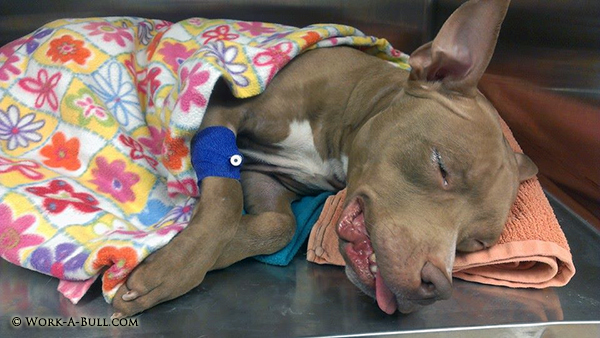 expected at a tune of $830 dollars with all the necessary things for surgery plus the bill of $125 she had already racked up with x-rays, etc. It didn’t stop me from cringing at the bill but it was a little easier pill to swallow since I knew she could be gotten in that day without paying emergency room costs or allowing for 24-hours to pass into a more complicated extraction area like her intestines.
expected at a tune of $830 dollars with all the necessary things for surgery plus the bill of $125 she had already racked up with x-rays, etc. It didn’t stop me from cringing at the bill but it was a little easier pill to swallow since I knew she could be gotten in that day without paying emergency room costs or allowing for 24-hours to pass into a more complicated extraction area like her intestines.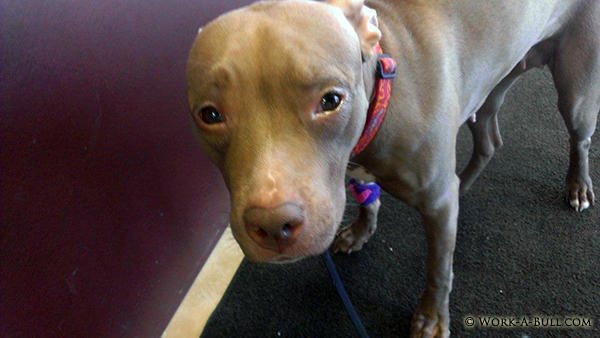 Mika went into surgery at round 12pm. The surgery took around a half an hour from start to finish and was, in relative terms, a simple exploratory surgery because she hadn’t passed any of the items into nastier territory. My vet, Dr. Eugene over at
Mika went into surgery at round 12pm. The surgery took around a half an hour from start to finish and was, in relative terms, a simple exploratory surgery because she hadn’t passed any of the items into nastier territory. My vet, Dr. Eugene over at  Winter is dragging on and on…and on. It seems that our winter-predicting groundhog friend, Punxsutawney Phil, has said another six weeks of this cold, nasty weather that has held the dogs pretty much hostage in the house other than trips to indoor venues and the occasional winter event – like the snow pulls we’ve attended. The dogs are going stir crazy and all that pent up energy has expressed itself in a few inappropriate actions too since they’ve started to nitpick and nag at each other more than usual. It’s getting rather old but we thankfully have a few options to exercise not only their minds but their bodies as well – the treadmill.
Winter is dragging on and on…and on. It seems that our winter-predicting groundhog friend, Punxsutawney Phil, has said another six weeks of this cold, nasty weather that has held the dogs pretty much hostage in the house other than trips to indoor venues and the occasional winter event – like the snow pulls we’ve attended. The dogs are going stir crazy and all that pent up energy has expressed itself in a few inappropriate actions too since they’ve started to nitpick and nag at each other more than usual. It’s getting rather old but we thankfully have a few options to exercise not only their minds but their bodies as well – the treadmill.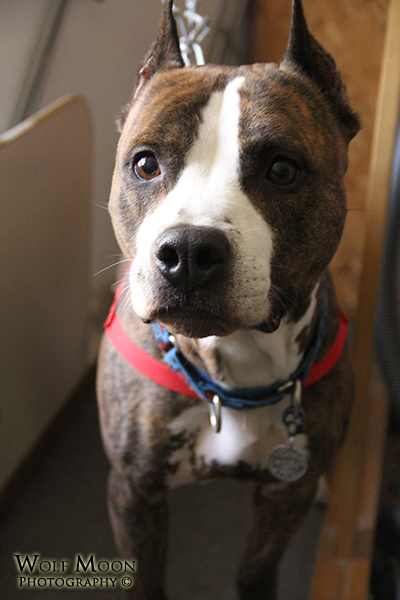 their canine companions, finding these types of exercise equipment available is becoming more and more readily available. Years ago, when I first got into the APBT as a breed enthusiast, having a dog-powered treadmill and the use was often linked by everyday pet owners as a sign of dog fighting. Thankfully, this is no longer the case and much of the so-called dog fighting propaganda is being realized to be useful for all breeds and types of dogs.
their canine companions, finding these types of exercise equipment available is becoming more and more readily available. Years ago, when I first got into the APBT as a breed enthusiast, having a dog-powered treadmill and the use was often linked by everyday pet owners as a sign of dog fighting. Thankfully, this is no longer the case and much of the so-called dog fighting propaganda is being realized to be useful for all breeds and types of dogs.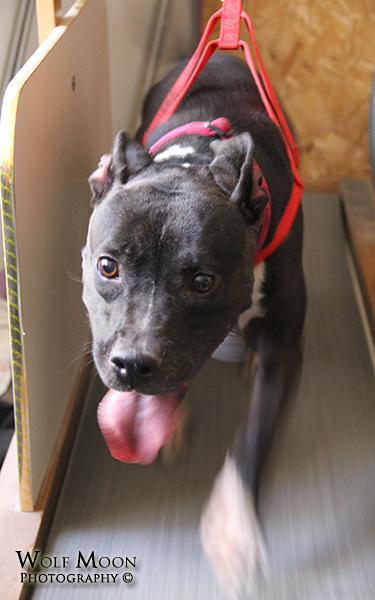 In the case of electric-type treadmills, many people convert humane-designed treadmills for the use with their canine companions but there are other options available which are geared in size and type toward canine companions. They are free-spinning like the slat-type treadmill and will typically allow for a more lean muscle-type to be created. For many people, this is the easiest option because you can find inexpensive electric treadmills (often called e-mills) on places like Craigslist for next to nothing. The only down fall, in my opinion, is that you have to watch and gauge when your dog has had
In the case of electric-type treadmills, many people convert humane-designed treadmills for the use with their canine companions but there are other options available which are geared in size and type toward canine companions. They are free-spinning like the slat-type treadmill and will typically allow for a more lean muscle-type to be created. For many people, this is the easiest option because you can find inexpensive electric treadmills (often called e-mills) on places like Craigslist for next to nothing. The only down fall, in my opinion, is that you have to watch and gauge when your dog has had 